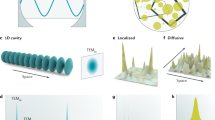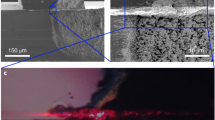Abstract
Random lasers1 are fascinating devices due to the absence of a conventional cavity structure and their counterintuitive lasing mechanism. However, they are also notorious for their unpredictability. Despite their many unusual properties2,3,4,5, random lasers are unlikely to achieve the ubiquitous acceptance of conventional lasers unless the underlying lasing mechanisms that govern their operation are thoroughly understood and their exotic properties are appropriately regulated. Recent demonstrations of localized random lasers are considered a breakthrough in the field because structural disorders were engineered in a top-down manner6,7,8. Nevertheless, the origin of the lasing phenomenon and the controllability of these devices have not been adequately addressed. Lately, we have experimentally proven that photonic band-tail eigenstates—manifestations of photonic Anderson localizations—are responsible for random lasing in a compositionally disordered photonic crystal platform9. Herein, we demonstrate that the process of governing the band-tail states offers a unique opportunity to finally regulate random lasers.
This is a preview of subscription content, access via your institution
Access options
Access Nature and 54 other Nature Portfolio journals
Get Nature+, our best-value online-access subscription
$29.99 / 30 days
cancel any time
Subscribe to this journal
Receive 12 print issues and online access
$209.00 per year
only $17.42 per issue
Buy this article
- Purchase on Springer Link
- Instant access to full article PDF
Prices may be subject to local taxes which are calculated during checkout



Similar content being viewed by others
Data availability
The data that support the plots in this paper and the other findings of this study are available from the corresponding author upon reasonable request.
References
Wiersma, D. S. The physics and applications of random lasers. Nat. Phys. 4, 359–367 (2008).
Ghofraniha, N. et al. Experimental evidence of replica symmetry breaking in random lasers. Nat. Commun. 6, 6058 (2015).
Redding, B., Choma, M. A. & Cao, H. Speckle-free laser imaging using random laser illumination. Nat. Photon. 6, 355–359 (2012).
Türeci, H. E., Ge, L., Rotter, S. & Stone, A. D. Strong interactions in multimode random lasers. Science 320, 643–646 (2008).
Van der Molen, K. L., Tjerkstra, R. W., Mosk, A. P. & Lagendijk, A. Spatial extent of random laser modes. Phys. Rev. Lett. 98, 143901 (2007).
Liu, J. et al. Random nanolasing in the Anderson localized regime. Nat. Nanotechnol. 9, 285–289 (2014).
Noh, H. et al. Control of lasing in biomimetic structures with short-range order. Phys. Rev. Lett. 106, 183901 (2011).
Yang, J. K. et al. Lasing modes in polycrystalline and amorphous photonic structures. Phys. Rev. A 84, 033820 (2011).
Lee, M. et al. Anderson localizations and photonic band-tail states observed in compositionally disordered platform. Sci. Adv. 4, e1602796 (2018).
Lawandy, N. M., Balachandran, R. M., Gomes, A. S. L. & Sauvain, E. Laser action in strongly scattering media. Nature 368, 436–438 (1994).
Cao, H. et al. Random laser action in semiconductor powder. Phys. Rev. Lett. 82, 2278 (1999).
Frolov, S. V., Vardeny, Z. V., Yoshino, K., Zakhidov, A. & Baughman, R. H. Stimulated emission in high-gain organic media. Phys. Rev. B 59, R5284 (1999).
Anderson, P. W. The question of classical localization: a theory of white paint? Phil. Mag. B 52, 505–509 (1985).
Schwartz, T., Bartal, G., Fishman, S. & Segev, M. Transport and Anderson localization in disordered two-dimensional photonic lattices. Nature 446, 52–55 (2007).
Zeng, Y. et al. Designer multimode localized random lasing in amorphous lattices at terahertz frequencies. ACS Photon. 3, 2453–2460 (2016).
Stano, P. & Jacquod, P. Suppression of interactions in multimode random lasers in the Anderson localized regime. Nat. Photon. 7, 66–71 (2013).
Vynck, K., Burresi, M., Riboli, F. & Wiersma, D. S. Photon management in two-dimensional disordered media. Nat. Mater. 11, 1017–1022 (2012).
Sebbah, P. & Vanneste, C. Random laser in the localized regime. Phys. Rev. B 66, 144202 (2002).
Leonetti, M., Conti, C. & Lopez, C. The mode-locking transition of random lasers. Nat. Photon. 5, 615–617 (2011).
Gottardo, S., Cavalieri, S., Yaroshchuk, O. & Wiersma, D. S. Quasi-two-dimensional diffusive random laser action. Phys. Rev. Lett. 93, 263901 (2004).
Wiersma, D. S. & Cavalieri, S. Temperature-controlled random laser action in liquid crystal infiltrated systems. Phys. Rev. E 66, 056612 (2002).
Van Mieghem, P. Theory of band tails in heavily doped semiconductors. Rev. Mod. Phys. 64, 755–793 (1992).
John, S. Localization of light. Phys. Today 44, 32–40 (1991).
Kim, S. et al. Simultaneous observation of extended and localized modes in compositional disordered photonic crystals. Phys. Rev. A 88, 023804 (2013).
Kim, S., Yoon, S., Seok, H., Lee, J. & Jeon, H. Band-edge lasers based on randomly mixed photonic crystals. Opt. Express 18, 7685–7692 (2010).
Conti, C. & Fratalocchi, A. Dynamic light diffusion, three-dimensional Anderson localization and lasing in inverted opals. Nat. Phys. 4, 794–798 (2008).
Seassal, C. et al. InP bonded membrane photonics components and circuits: toward 2.5 dimensional micro-nano-photonics. IEEE J. Sel. Top. Quantum Electron. 11, 395–407 (2005).
Park, Y., Kim, S., Moon, C., Jeon, H. & Kim, H. J. Butt-end fiber coupling to a surface-emitting Γ-point photonic crystal bandedge laser. Appl. Phys. Lett. 90, 171115 (2007).
Louvion, N. et al. Local observation and spectroscopy of optical modes in an active photonic-crystal microcavity. Phys. Rev. Lett. 94, 113907 (2005).
Acknowledgements
This work was supported by Samsung Research Funding and Incubation Center of Samsung Electronics under project no. SRFC-MA1801-02. The collaboration between Seoul National University and Institut des Nanotechnologies de Lyon/Ecole Centrale de Lyon was pursued in the framework of the French–Korean Laboratoire International Associé ‘Center for Photonics and Nanostructures’.
Author information
Authors and Affiliations
Contributions
M.L. conducted the majority of the experimental work, including the design, fabrication, measurements and simulations. S.C. and C.S. provided the bonded InAsP MQW wafers and were involved in the NSOM measurements. H.J. conceived and directed the research. All authors contributed to the scientific discussions and the preparation of the manuscript.
Corresponding author
Ethics declarations
Competing interests
The authors declare no competing interests.
Additional information
Publisher’s note: Springer Nature remains neutral with regard to jurisdictional claims in published maps and institutional affiliations.
Supplementary information
Supplementary Information
This file contains more information about the work and Supplementary Figs. 1–6.
Rights and permissions
About this article
Cite this article
Lee, M., Callard, S., Seassal, C. et al. Taming of random lasers. Nat. Photonics 13, 445–448 (2019). https://doi.org/10.1038/s41566-019-0407-5
Received:
Accepted:
Published:
Issue Date:
DOI: https://doi.org/10.1038/s41566-019-0407-5
This article is cited by
-
Structural design of random lasers with specified emission bands
Optical Review (2024)
-
2D tunable all-solid-state random laser in the visible
Scientific Reports (2023)
-
Controlling random lasing action
Nature Physics (2022)
-
Controlling wave fronts with tunable disordered non-Hermitian multilayers
Scientific Reports (2021)
-
Probing nanoscale fluctuation of ferromagnetic meta-atoms with a stochastic photonic spin Hall effect
Nature Nanotechnology (2020)



